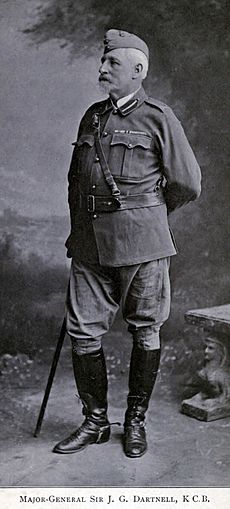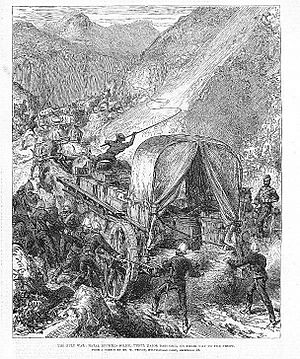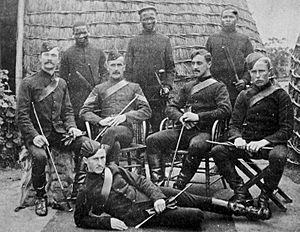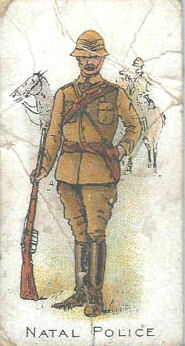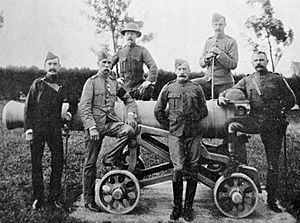Natal Mounted Police facts for kids
The Natal Mounted Police (NMP) was a special police force in the old Colony of Natal in South Africa. It was started in 1874 by Major John Dartnell, a farmer and former British Army officer. The NMP was like a police force and a military group combined. Its job was to help protect Natal. When needed, other local volunteer groups like the Natal Carbineers would help them.
The NMP had European officers and also African members. These brave men fought in important battles like the Battle of Isandlwana and at Rorke's Drift during the Zulu War in 1879. Some of them sadly died in these battles.
Contents
Forming the Natal Mounted Police (1874-1894)
The government of Natal decided to create the Natal Mounted Police in 1874. This happened after a local uprising led by Chief Langalibalele. However, it took some time for the government to give them the money they needed.
Major John George Dartnell (1838-1913) was the first leader of the NMP. He had been an officer in the British Army. The very first trooper to join was Edward Babington in 1874. Major Dartnell once said that his new recruits were a mix of people. Many were former soldiers, sailors, or people looking for a new start. He described them as tough and ready for anything. They were cheerful and willing to work hard, especially away from the towns.
In its early days, the Natal Mounted Police had 50 white members and 150 African members. They didn't have many people or much equipment. Even so, they became known for being a friendly and effective police force. Their first main office was at Fort Napier in Pietermaritzburg.
In 1877, 25 men from the NMP guarded Sir Theophilus Shepstone. He was a special official who went to Pretoria to announce that Britain was taking control of the Transvaal. No one openly fought against this change.
The Zulu War (1879)
The Natal Mounted Police didn't see much fighting until the Zulu War in 1879. During this war, they joined the British Army. They rode into the Zulu Kingdom with the main British force led by Lord Chelmsford.
One group of 97 NMP men, led by Major Dartnell, went to find the main Zulu army of Cetshwayo kaMpande. Another group of 34 NMP men fought in the terrible Battle of Isandlwana on January 22, 1879. Out of this group, 25 were killed. Twenty-one of them died fighting alongside 19 Natal Carbineers in a brave "last stand."
Three NMP men were in the hospital at Rorke's Drift. They also fought in the famous Battle of Rorke's Drift. One of them, Sidney Hunter, was killed there. Major Dartnell's group returned to Isandlwana on the evening of the battle. They spent the night among the destroyed camp and the bodies of their friends. The next morning, they joined Lord Chelmsford's group as they moved towards Rorke's Drift.
Later in the war, Sir Garnet Wolseley arrived to take over command. The Natal Mounted Police guarded him during his visit to Zululand in the final days of the war.
Other Rebellions and Duties
Natal Mounted Policemen also served in other conflicts. They fought in the Basuto Gun War (1880–81). Here, they protected mountain passes in the Drakensberg from attacks by the Basuto. They also helped during the Transvaal Rebellion (1880–81). The NMP formed a mounted military force along the border with the Transvaal.
After these rebellions, the NMP went back to normal police duties. In 1880, they guarded the Empress Eugénie when she visited Natal. She came to see where her son, Napoléon, had been killed during the Zulu War the year before.
The NMP members received special medals for their service during this time. These included the South Africa Medal (1877–79) for the Zulu War. They also received the Cape of Good Hope General Service Medal for the Basutoland Rebellion. After 1881, police stations were set up across Natal. Policing often meant long patrols in far-off areas. By 1885, the NMP had 300 white officers and 25 African members.
The Natal Police (1894-1913)
In 1894, the Natal Mounted Police joined with other police and prison services in Natal. They became known as the Natal Police (NP). This name stayed until the force was closed down in 1913. Commandant John Dartnell became the first Chief Commissioner of Police for this new, larger force.
New Ways of Policing
The Natal Police were pioneers in using fingerprinting in Africa. This was for identifying criminals. Sub-Inspector W. J. Clarke of the Natal Police's Criminal Investigation Department (CID) was very interested in this. He saw how well fingerprinting worked in Calcutta in 1897. He tried to start the system in Natal in 1898.
At first, his bosses weren't as excited about this new idea. So, Clarke started the system using his own money. Once it helped solve more crimes and make more arrests, fingerprinting became a regular police method in Natal. It worked so well that by 1910, the Natal Police's CID had more fingerprints on record than Scotland Yard in London. Clarke later took over from Dartnell as Chief Commissioner in 1903.
The Boer War (1899-1902)
In September 1899, when war with the Boer Republics seemed likely, the Natal Police were put on high alert. They watched the borders closely. When war officially started in October 1899, the first NMP members were captured by the Boers at De Jager's Drift.
All the Natal Police in northern Natal were sent to Dundee. They fought in the Battle of Talana Hill on October 20, 1899. After this, the British forces, including 90 men of the Natal Police led by Colonel Dartnell, moved to Ladysmith. There, they became trapped during the Siege of Ladysmith. The Natal Police also faced fire at Lombard's Kop on October 30, 1899. During the siege, one Natal Police man was killed, three were wounded, and three more died from illness.
On December 7, 1899, during the siege, some British forces launched a night attack from Ladysmith on Gun Hill. The Natal Police guarded the left side of the attack. The British surprised the Boers, who had to retreat and leave their cannons. The Natal Police were on the other side of a hill and didn't hear the signal to return. They were late getting back to Ladysmith.
The NP saw more action on January 5, 1900. A group near Caesar's Camp was fired upon during a major Boer attack. The next morning, the Boers shot the NP's horses. This forced the policemen to walk back while being shot at. After a British counterattack, the Boers pulled back. The Siege of Ladysmith ended on February 28, 1900. An advance group, which included 15 members of the Natal Police, reached Ladysmith.
Those Natal Police members who were not in Ladysmith during the siege joined a military group called the Natal Police Field Force (NPFF). One part of this force was the bodyguard for General Sir Redvers Buller VC. He was the commander of the British forces in Natal.
Dartnell retired in 1903 as Major-General Sir John Dartnell, KCB, CB.
Later Service and End of the Force
About 1,100 men of the Natal Police fought in the 1906 Natal Rebellion. This was a Zulu uprising against British rule and taxes in Natal.
After South Africa became a unified country in 1910, the old colonial police forces were slowly closed down. The Natal Police stopped existing in 1913. Its police officers were moved to new military units, like the 2nd and 3rd Regiments of the South African Mounted Riflemen. Others joined the new South African Police or the South African Prisons Service.
Images for kids


